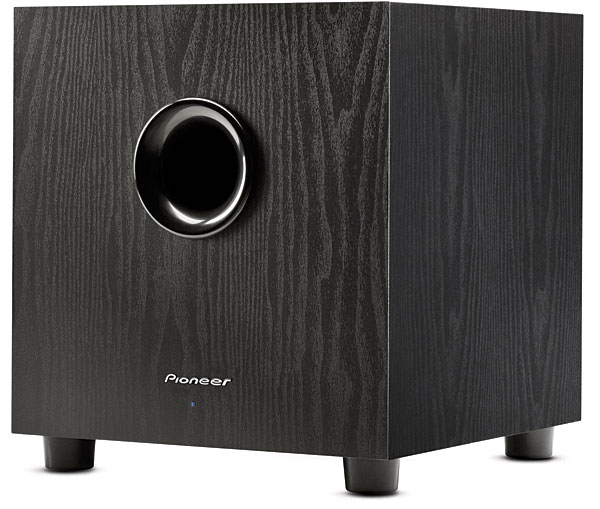Yes! Been waiting for a review on these new speakers. Now I DEFINITELY want these speakers!
Pioneer SP-PK22BS Speaker System Page 2
I like to mercilessly plunge speakers into the deep end of the pool with an action movie so I can feel them at a visceral level before I even think about how they sound. A violent scene at the opening of the comic bank-heist thriller Flypaper might have brutalized a lesser speaker. But these monitors held up well, decently controlling the bass/midrange gunshots and keeping the midrange/high-frequency assault of smashing glass from flattening my ears. They like power. Between that and the center’s scrupulous avoidance of any sonic characteristics akin to video edge enhancement, hearing dialogue required keeping the master volume high enough, which in turn kept the soundfield solid.
Footnote is a comic drama about two feuding Talmudic scholars, father and son, and their divergent searches for truth. It comes with a quirky and dark-textured orchestral soundtrack that constantly comments on the foibles of the characters with turbulent melodies and mordant pizzicato. This offered a forecast of the music demos: These speakers define orchestral structure like masters. With dialogue in Hebrew, which I can’t speak, I was free to focus on the sound of voices, which were tremendously natural and unhyped. In an early scene in which a voice booms out of a P.A. system, I was also impressed by the sheer physicality of the speakers. They made the simulated P.A. a wall of sound with the impression of height. I assumed that the deliberately fat low-frequency component in the P.A. voice was booming out of the sub, but when I put my ear to the sub’s front port and felt with my fingers for its down-firing woofer, I discovered that the voice’s bottom end was actually coming out of the center’s back ports.

In the next demo—season one of Star Trek: The Next Generation—voices were tailored for TV speakers and consequently moved to the opposite extreme, with the ports almost silent. So Patrick Stewart’s Shakespearean tones were leaner. While this was not exactly audiophile-approved material, I’ve never heard it sound so good, thanks to both the restoration and the system.
The Heavens Open
Beethoven’s Ninth Symphony was the 2000 version with Claudio Abbado conducting the Berlin Philharmonic and vocal soloists Thomas Moser and Karita Mattila. As released in 24/96 by HDtracks, the FLAC files have the dynamic extremes of an action movie—and then some. I set the volume just loud enough to make the first movement’s opening notes faintly perceptible. This made the loudest passages very stormy indeed, but the speakers remained in their comfort range, admirably defining the orchestra’s massive dynamic structures without losing its tonal focus.

The recording has a middlerow concert hall perspective, which the speakers maintained consistently, pushing the solo singers to the front of the stage, where they should be.
I’ve been enjoying the six initial Blue Note releases from HDtracks in FLAC 24/192, including Eric Dolphy’s Out to Lunch!. It had the ease and warmth of vinyl combined with the kind of resolution known mostly to owners of four-figure phono cartridges. This played to the strong suits of the Pioneer speakers, especially their well-sculpted midrange and slightly laid-back but well-lit top end. Imaging of the leader’s bass clarinet—always a startling sound—was even richer than usual.
While the CD release of Talking Heads’ Fear of Music is a little hard at the top compared with my (damaged) vinyl—and I haven’t heard the DVD-Audio version—the groovalicious drum kit of Chris Frantz and the melodic bass lines of Tina Weymouth come through like champs in any format as long as the system allows. The handoff at the crossover was very good as the modestly powered sub took over from the bass-ported satellite speakers.
The Pioneer SP-BS22-LR monitor and SP-C22 center manage to improve upon some of the best affordable speakers of all time, with improvements from top to bottom. Whereas their predecessors were good mates for, say, a $599 receiver, I think you could go to $1,000 for the maximum performance gain per dollar. Once again, Andrew Jones has delivered a gift to the surround audiophile on a budget.
- Log in or register to post comments


Almost there. For the 3rd generation just get rid of that fake wood grain and have rectangular grilles and they will sell a lot more.

Thanks for the review. I'm awaiting you review of the tower speakers. These pioneer are priced really well and if the towers measure and sound great, I maybe upgrading my Polk monitors to the Pioneer's.

I second the motion for a review of the system with the new towers in the front. I've been eyeing these speakers for quite some time now and would love a review of these including the towers.





































































